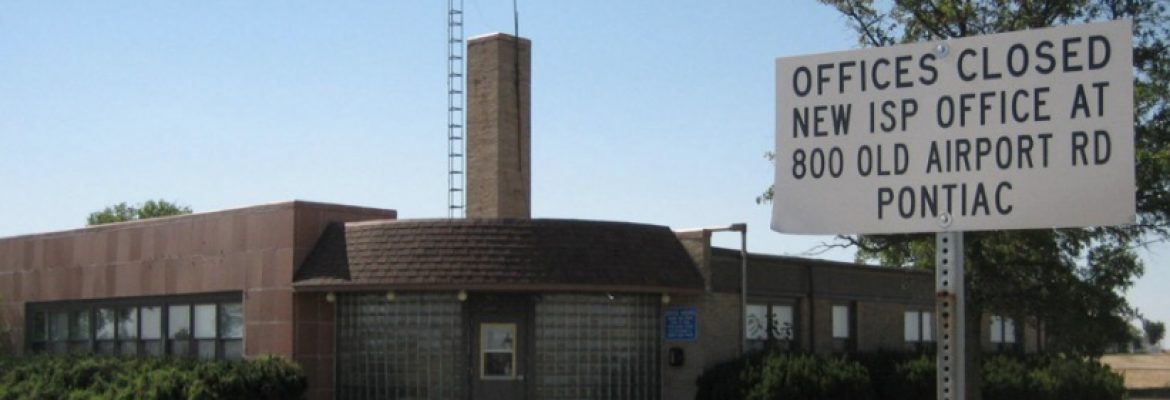State Police Office, Pontiac, Illinois, USA
Built in 1941, the District 6 Illinois State Police office is an example of sleek Art Moderne architecture that reflects the streamlined design of automobiles of the era. The building has curved corners, smooth surfaces, and structural glass bricks, all elements typical of Art Moderne design. Facing an abandoned two-lane section of old Route 66, the office is modest. It’s practical. It’s tan. Motorists could easily drive right past it without realizing its considerable significance, but slow down two miles south of Pontiac and take a look at the building.
In the decades before airbags, before seat belts and “click it or ticket” campaigns, brown-suited State troopers with visors patrolled Illinois highways, especially the heavily travelled corridor of Route 66. The Illinois State Police were first organized in 1922 after the election of Governor Len Small, who ran on the slogan “take Illinois out of the mud.”
That year, eight troopers began patrolling the 1,100 miles of paved roads in Illinois. They used surplus World War I uniforms (pieces included a snug cap, long-sleeved shirt, vest, jodhpurs, and boots to the knee) and motorcycles, and they did not wear helmets. The State Police headquarters was a desk in the chief’s house in Kankakee, Illinois. The patrol’s early emphasis was on truck regulation–overloaded trucks damaged highway pavement–and speeding was a secondary concern.
By 1923, 20 officers were on patrol, covering 109,705 miles of road. Doing the math, that comes to 5,485 miles of road per officer per day. Little wonder, then, that the force grew rapidly. In 1924, 100 officers were on patrol at salaries of $150 per month. Four years later, Illinois State Police employed a chief, 12 sergeants, 140 officers, and six mechanics. That was the year that troopers got their first patrol cars–1927 Chrysler Coupes issued only to sergeants. With bug-eyed headlights, wheels with spokes, wide running boards, and an extra tire mounted on the back, the Chryslers were chunky, squarish cars, much like early Fords. Ads from the era boasted that the 1927 Chrysler would reach 60 “mean miles per hour.”
By the mid 1930s, troopers were using radios, and the Illinois State Police staff totaled 350. About this time, Illinois began building police headquarters in various districts across the State. By 1942, the Pontiac station was in operation, with one wing for administration and a second wing for garages. The utilitarian, sleek interior was finished out with terrazzo floors, plaster walls, and built-in cupboards.
Traffic along Route 66 continued to increase throughout the 1940s, and the headquarters was busy round the clock. In 1944, the route was widened to four lanes through this region of Illinois, and two additional highway lanes were constructed directly in front of the building. Speed limits were imposed during the 1950s. By then, officers drove distinctively marked black and white cars with crackling radios and flashing blue lights. Their work had a clear focus–reducing the rapidly rising death toll from highway accidents
The construction of Interstate 55, about a half mile to the west of Route 66 during the 1970s, led to a decrease in traffic on Route 66. The Illinois State Police remained headquartered in the building until 2003 when the police moved to a new facility in Pontiac. The historic headquarters is vacant today, but remains an important local landmark. It was listed in the National Register in 2007. Livingston County has plans to develop the site for public use as a park. At its center will be the building that housed for nearly seven decades the officers who maintained a constant and critical presence on this section of Route 66.
Route 66 | Creative Design © Monika Newbound | All Rights Reserved 2017


